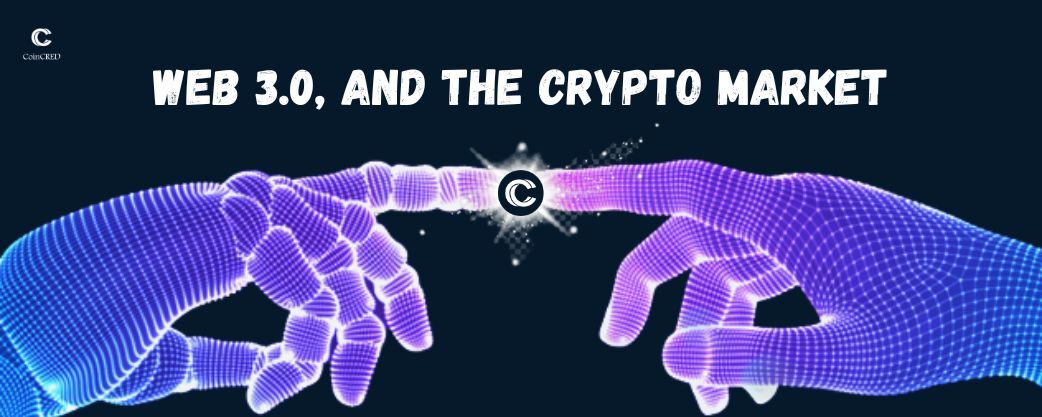The World Demands: Web 3.0, And the Crypto Market

Introduction
Web 3.0 is creating a lot of buzz in the tech world, especially in the crypto market; it is regarded as crypto's key to the mainstream market. Web 3.0 and the crypto market are based on blockchain technology. In this blog, we will discuss the need for Web 3.0 worldwide and its effects on the crypto market. We will know about it through the evolution of the World Wide Web.
Our interactions with the internet world are changing into something more decentralised, safe, and empowering in this period of unrelenting technical advancement. The symbiotic relationship between the need for Web 3.0 and the disruptive force of the cryptocurrency market as the world adjusts to a new online era. Come along on a voyage through the winds of change that are transforming the way we interact with technology and opening the door to a more inclusive and decentralized digital future.
Web 1.0
The advent of web technology was in the 1990s. The earliest version of the Internet or Web 1.0 could only be used for reading purposes. It was a type of Syntactic web. In this version of the internet, participants were content consumers, whereas makers were web developers. The time frame of Web 1.0 was 1991 to 2004. The websites were in a static form in a hypertext markup language(HTML).
Web 2.0
The upgraded version of the internet was known as Web 2.0. Darcy DiNucci is credited for coining the term web 2.0. It started in 2004. The fundamental distinction between Web 1.0 and Web 2.0 is that of being static and interactive. The advent of more advanced languages like javascript, CSS and python led to interactive internet like social media, for example, Facebook, Youtube, Twitter, Instagram etc. Here the participants were not only content consumers but they are also content creators as well. It is now possible to upload any video, information blog or article through advanced languages. Participants can also comment on the uploaded content as well.
Web 3.0
It is the upcoming version of the internet. It is the more advanced version of the internet. Plus, it fundamentally differs from earlier versions of Web 1.0 and 2.0 because earlier versions were formed on the centralised system, whereas the new Web 3.0 is formed on a decentralised system. The term web 3.0 was coined by Gavin Wood, co-founder of Ethereum and founder of PolkaDot.
The need for Web 3.0 emerged due to various factors, like information arbitrage, security breaches, data and privacy leaks, etc. In today's world data is the new fuel of the world economy. Our data stored on the internet, any social media platform, or cloud platform is misused or used to manipulate us through data mining and other tools that help tech giants or corporations gain profits. We all know the story of whistler Edward Snowden who spilled the beans on data privacy leakage in the US, the case of the Cambridge Analytica firm manipulating voters in Indian elections and not to forget the recent case of Pegasus, Israeli spyware used against selected individuals.
So to prevent such a chain of events in future, the need for a decentralised web emerged. Web 3.0 is a semantic web. Tim Berners Lee coined the term semantic web; he was CERN's inventor of web technology. The word got into its real essence with the advent of web 3.0. Here the sole data ownership is with the consumer, and their information is not stored on any third-party database and servers.
Web 3.0 uses blockchain technology for decentralisation. It also uses many other technologies like Artificial Intelligence, Machine learning, the Internet of Things (IoT), Meta-verse etc.
Through Web 3.0, we can get tailored, relevant content without compromising our right to privacy.
Through the usage of Artificial Intelligence, we can get a superior quality experience of Search browsing, improved advertising and better customer support, for example, the use of a chatbot system which minimises the customer support cost and smoothens operations of the company.
Use of web 3.0 on the crypto market
Ethereum is the earliest market player to work on Web 3.0. It has envisioned adapting Web 3.0 to its fullest form. It has built decentralised applications in which there is no requirement for personal details, and there is no central authority involved that can tamper with transactions.
There are other platforms as well which are based on Web 3. Odysee project is a decentralised platform powered by a blockchain peer-to-peer network. It is a social networking and video-sharing platform built by LBRY, which directly rewards its content creators LBRY allows creators to upload original content pieces and decide how they wish to monetise them. Content creators are paid for the generated views with the LBRY token, while consumers can purchase their content using the same coin.
We all are aware that data is the new oil to protect our data privacy and intellectual property rights. Ocean Market App enables data owners to publish their content using Ocean data tokens and users to purchase access to the data, while data providers are rewarded with OCEAN tokens.
Conclusion
Web 3.0 is still in its infancy stage. Web 3.0 will grow slowly and gradually at its own pace and will unfurl many new things shortly. Advanced-level research is in the process of optimising Web 3.0 technology. Furthermore, it can create decentralised autonomous organisations (DAOs) and global-scale decentralised autonomous companies (DACs). It will transform Thomas Hobbes's(English political thinker) brutish world into Immanuel Kant's perpetual peace world as it will create a trustworthy ecosystem, at least, we can certainly say it will eliminate online frauds from the web through cryptocurrency.












